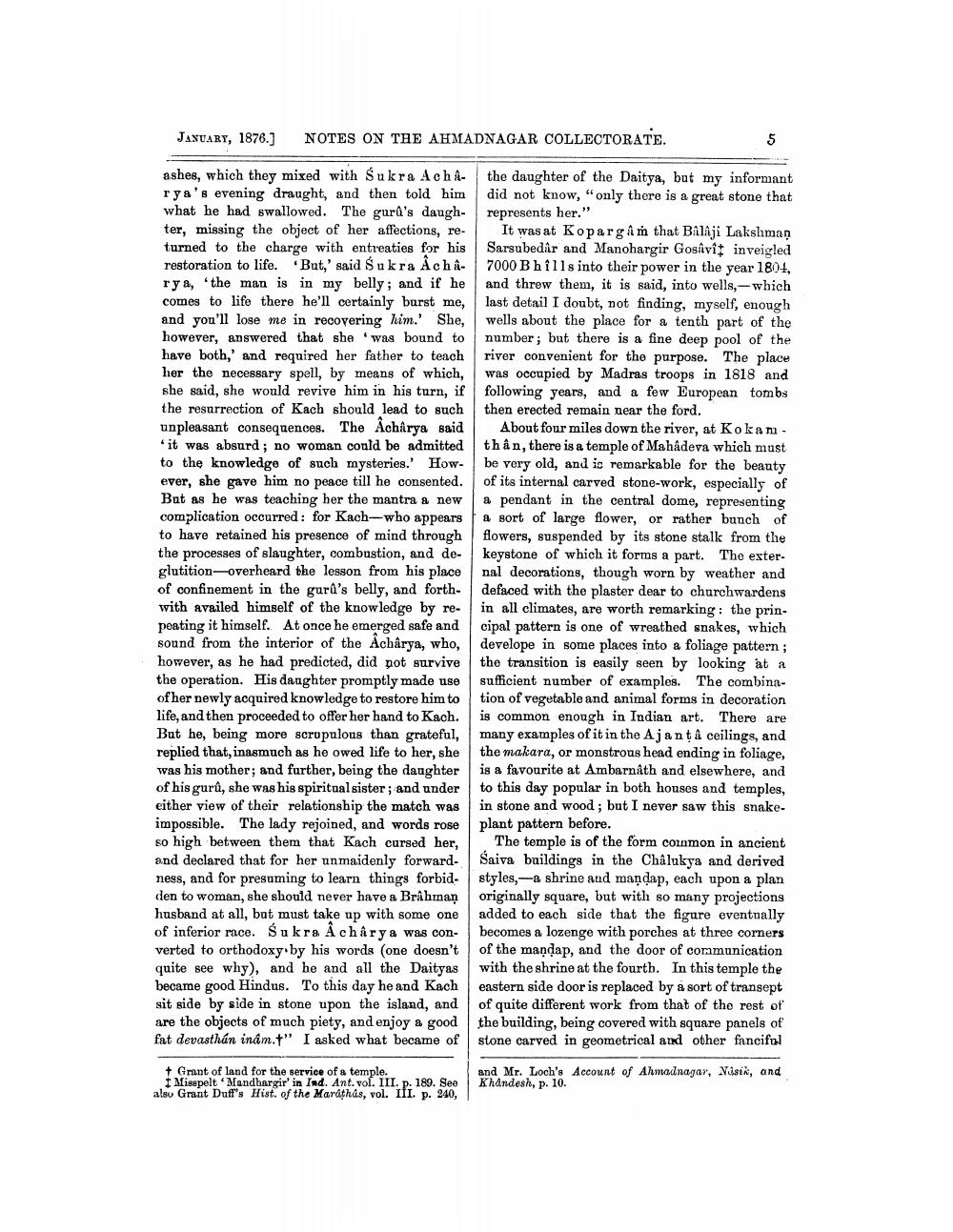Book Title: Indian Antiquary Vol 05 Author(s): Jas Burgess Publisher: Swati Publications View full book textPage 9
________________ JANUARY, 1876.] NOTES ON THE AHMADNAGAR COLLECTORATE. ashes, which they mixed with Sukra Achirya's evening draught, and then told him what he had swallowed. The gurd's daughter, missing the object of her affections, returned to the charge with entreaties for his restoration to life. But,' said Sukra Acharya, the man is in my belly; and if he comes to life there he'll certainly burst me, and you'll lose me in recovering him.' She, however, answered that she was bound to have both,' and required her father to teach her the necessary spell, by means of which, she said, she would revive him in his turn, if the resurrection of Kach should lead to such unpleasant consequences. The Acharya said it was absurd; no woman could be admitted to the knowledge of such mysteries.' However, she gave him no peace till he consented. But as he was teaching her the mantra a new complication occurred: for Kach-who appears to have retained his presence of mind through the processes of slaughter, combustion, and deglutition-overheard the lesson from his place of confinement in the gura's belly, and forthwith availed himself of the knowledge by repeating it himself. At once he emerged safe and sound from the interior of the Acharya, who, however, as he had predicted, did not survive the operation. His daughter promptly made use of her newly acquired knowledge to restore him to life, and then proceeded to offer her hand to Kach. But he, being more scrupulous than grateful, replied that, inasmuch as he owed life to her, she was his mother; and further, being the daughter of his guru, she was his spiritualsister; and under either view of their relationship the match was impossible. The lady rejoined, and words rose so high between them that Kach cursed her, and declared that for her unmaidenly forwardness, and for presuming to learn things forbidden to woman, she should never have a Brahman husband at all, but must take up with some one of inferior race. Sukra Acharya was converted to orthodoxy by his words (one doesn't quite see why), and he and all the Daityas became good Hindus. To this day he and Kach sit side by side in stone upon the island, and are the objects of much piety, and enjoy a good fat devasthan inám.t" I asked what became of the daughter of the Daitya, but my informant did not know, "only there is a great stone that represents her." It was at Koparg am that Balaji Lakshman Sarsubedar and Manohargir Gossvit inveigled 7000 B hills into their power in the year 1804, and threw them, it is said, into wells, which last detail I doubt, not finding, myself, enough wells about the place for a tenth part of the number; but there is a fine deep pool of the river convenient for the purpose. The place was occupied by Madras troops in 1818 and following years, and a few European tombs then erected remain near the ford. About four miles down the river, at Kokanthân, there is a temple of Mahadeva which must be very old, and is remarkable for the beauty of its internal carved stone-work, especially of a pendant in the central dome, representing a sort of large flower, or rather bunch of flowers, suspended by its stone stalk from the keystone of which it forms a part. The external decorations, though worn by weather and defaced with the plaster dear to church wardens in all climates, are worth remarking: the principal pattern is one of wreathed snakes, which develope in some places into a foliage pattern; the transition is easily seen by looking at a sufficient number of examples. The combination of vegetable and animal forms in decoration is common enough in Indian art. There are many examples of it in the Ajant à ceilings, and the makara, or monstrous head ending in foliage, is a favourite at Ambarnath and elsewhere, and to this day popular in both houses and temples, in stone and wood; but I never saw this snakeplant pattern before. The temple is of the form common in ancient Saiva buildings in the Chalukya and derived styles,--a shrine and mandap, each upon a plan originally square, but with so many projections added to each side that the figure eventually becomes a lozenge with porches at three corners of the mandap, and the door of communication with the shrine at the fourth. In this temple the eastern side door is replaced by a sort of transept of quite different work from that of the rest of the building, being covered with square panels of stone carved in geometrical and other fanciful + Grant of land for the service of a temple. I Misspelt Mandhargir'in Ind. Ant. vol. III. p. 189. See alsu Grant Duffs Hist. of the Marathas, vol. III. p. 240, and Mr. Loch's Account of Ahmadnagar, Musik, and Khandesh, p. 10.Page Navigation
1 ... 7 8 9 10 11 12 13 14 15 16 17 18 19 20 21 22 23 24 25 26 27 28 29 30 31 32 33 34 35 36 37 38 39 40 41 42 43 44 45 46 47 48 49 50 51 52 53 54 55 56 57 58 59 60 61 62 63 64 65 66 67 68 69 70 71 72 73 74 75 76 77 78 79 80 81 82 83 84 85 86 87 88 89 90 91 92 ... 438
